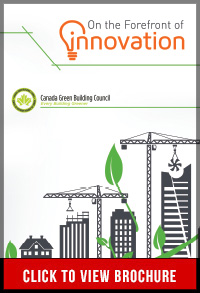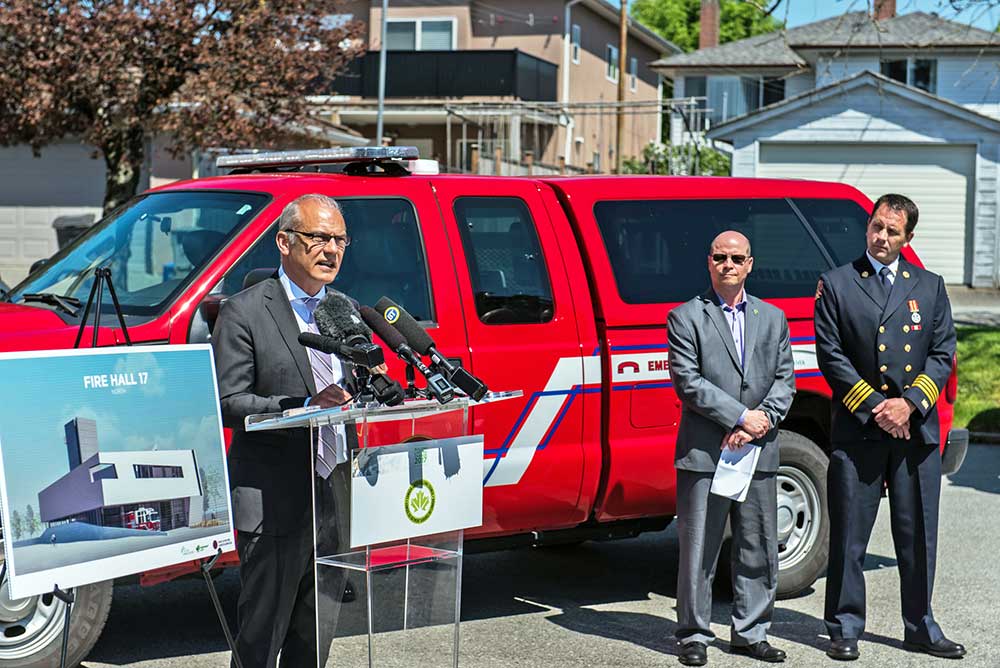On the Forefront of Innovation
 Within the last couple decades, the construction industry has seen a tremendous change, in not only technology used for construction practices but also in policies, regulations and standards which members in the industry work towards. The practice of sustainable building, or green building, has encouraged the P3 (private and public) sector to be mindful of their environmental impact when working on new buildings or renovating existing ones. Green building has not only improved the impact of the building in its surroundings, but has opened numerous opportunities for employment, and increased the standard of living for those who work or reside in a ‘green’ building. As Canada’s green building advocate and the only organization in Canada dedicated to increasing the adoption of green and sustainable buildings, the Canada Green Building Council (CaGBC) has been at the forefront of this change.
Within the last couple decades, the construction industry has seen a tremendous change, in not only technology used for construction practices but also in policies, regulations and standards which members in the industry work towards. The practice of sustainable building, or green building, has encouraged the P3 (private and public) sector to be mindful of their environmental impact when working on new buildings or renovating existing ones. Green building has not only improved the impact of the building in its surroundings, but has opened numerous opportunities for employment, and increased the standard of living for those who work or reside in a ‘green’ building. As Canada’s green building advocate and the only organization in Canada dedicated to increasing the adoption of green and sustainable buildings, the Canada Green Building Council (CaGBC) has been at the forefront of this change.
Recently, Business Elite Canada had the opportunity to get an update from CaGBC about some big changes the industry is seeing, and learn about where the future of green building is headed with Thomas Mueller, President and CEO of the Council. The Council has grown from three members in 2005 to the industry changing role it plays now, including a membership of over 1250 companies and organizations dedicated to sustainability.
Thomas Mueller, who joined the Council as a founding member of the Board of Directors in 2002, worked to establish the council to where it is today and in 2005 became the President and CEO. The not–for-profit organization has been involved in advocating green building policies with all levels of government and private sectors in Canada, and as a result has changed the way a developer or a designer would view and operate a project.
The CaGBC was responsible for adapting Leadership in Energy and Environmental Design (LEED) certification to the Canadian market, an industry standard which is now commonly used and has led to big changes – both to the benefit of the environment and to the operational bottom line. LEED is a rating system which is recognized internationally in over 150 countries as a standard for excellence in green building. It is hard nowadays to find a commercial office or a multi-use residential buildings that isn’t striving for LEED certification. Canada alone has over 7,000 LEED registered buildings and over 3,000 certified–making it the second highest number in the world.
But it is in the last two years that there have been pivotal changes in the way green building is viewed by key players in the industry. This was brought on by a new federal government that has been determined in its commitment to mitigating the negative effects of greenhouse gas emissions and its effect on a changing climate.
One of these trends is the emphasis on existing buildings, which stand to have the biggest impact in the built environment in terms of long-term reduction of emissions.
This change has been adopted not only by private sector owners, but increasingly institutional and government buildings are also taking notice of green building’s benefits. Tenants are also recognizing that greener office spaces lend themselves to healthier indoor environments, greater productivity and less absenteeism.
On May 29, CaGBC announced a made-in-Canada solution addresses carbon emissions from buildings
The carbon footprint of buildings – the result of energy use for construction, maintenance and operation – accounts for about one- third of greenhouse gas emissions in Canada, and its reduction has to be one of the focal points in climate action discussions.
At the beginning of 2017, Canada counted one billion square feet of projects with LEED (Leadership in Energy and Environmental Design) certification, says Mr. Mueller. “These green buildings perform well on energy and water efficiency, waste management, recycling, a healthy indoor environment and more – they also represent a high level of leadership that we can build on.”
The next step, Mr. Mueller asserts, has to be even more ambitious. “The Trudeau government changed the conversation by committing to a limit of less than two degrees Celsius of global warming,” he says. “With this goal, all of us need to think hard about how to get there, and this includes the building sector.”
The goal to advance carbon-neutral buildings catalyzed the development of the CaGBC’s Zero Carbon Building Standard, which assesses the performance of commercial, institutional and multifamily buildings and is the only program of its kind that makes carbon reductions the key indicator for building performance.
Mark Hutchinson, the CaGBC’s Vice President of Green Building Programs, says that most of the efforts in the building sector to date have been focused on improving energy performance. “Energy use is only one factor of [a building’s] carbon footprint, which also depends on the carbon-intensity of the local grid and fossil fuels used, for example,” he says. “Since the primary goal is curbing greenhouse gas emissions, we have to take a carbon-centric approach. Reducing emissions has to be the measure of our success.
“Since buildings are large, stationary users of energy that have long lifespans, they are prime places for investing in measures that reduce emissions,” says Mr. Hutchinson. He explains that new construction projects present an opportunity for creating low-emissions building stock for future generations. “New buildings can be designed for optimum efficiency and resiliency right from the start,” he says. But since over 80 per cent of existing buildings are expected to be still in operation in 2030, a large-scale market transformation can only be achieved when the environmental performance of existing buildings is also addressed, he adds. “Deep retrofits have to be part of the plan if we want to meet the building sector’s zero carbon objectives.”
The good news is that Canada’s green building sector is up to the task – and is among the most advanced in the world, says Mr. Hutchinson. “We are in a good position for reducing – and eventually eliminating – greenhouse gas emissions from building operations,” he explains. “Over the last decade or so, green building certification programs have raised the bar for energy efficiency and sustainable building practices. As a result, the way that buildings are being designed and constructed, and subsequently maintained and operated, has already changed substantially.”
Mr. Mueller says that as a framework for evaluating building performance, the Zero Carbon Building Standard can potentially enable governments to implement regulatory programs fostering greater sustainability. “A lot of green building efforts have been voluntarily, but governments are increasingly realizing the potential of the building sector for meeting environmental goals,” he says. “And we want to help prepare the industry for future changes, such as more stringent building codes, prices for carbon pollution as well as energy use in general.”
To ensure that the Zero Carbon Building Standard reflects the sector’s needs and priorities, it was developed with extensive industry input, says Mr. Mueller. “We wanted to make sure the program is attractive to the building industry and rigorous in its outcomes. It is also designed to help property owners and managers assess their buildings’ performance and gain recognition for leadership efforts.”
It is Mr. Mueller’s experience that there is a very strong business case associated with green buildings – and it encompasses environmental, economic and social sustainability. “Over their lifetime, sustainable buildings typically recover any additional capital costs that went into their construction or retrofit,” he explains. “And the shift to sustainable practices brings very solid business and economic opportunities and benefits.”
A focus on sustainability can help to guide investments towards furthering green building practices, renewable energy and energy efficiency technologies, says Mr. Hutchinson. “We see the standard as a next step for getting us to a low-carbon economy and driving an innovation agenda. It’s a made-in-Canada solution for addressing carbon pollution and climate change in the building sector.”
For those organizations looking to implement green construction, design and practices, including zero carbon, into their business model and building portfolio, the CaGBC has various educational programs, at introductory and at an advanced level to help companies and professionals learn the required skills they need to practice green building.
For more information on the CaGBC, visit their website at www.cagbc.org.
For more information on the new Zero Carbon Building Standard, visit www.cagbc.org/zerocarbon.






